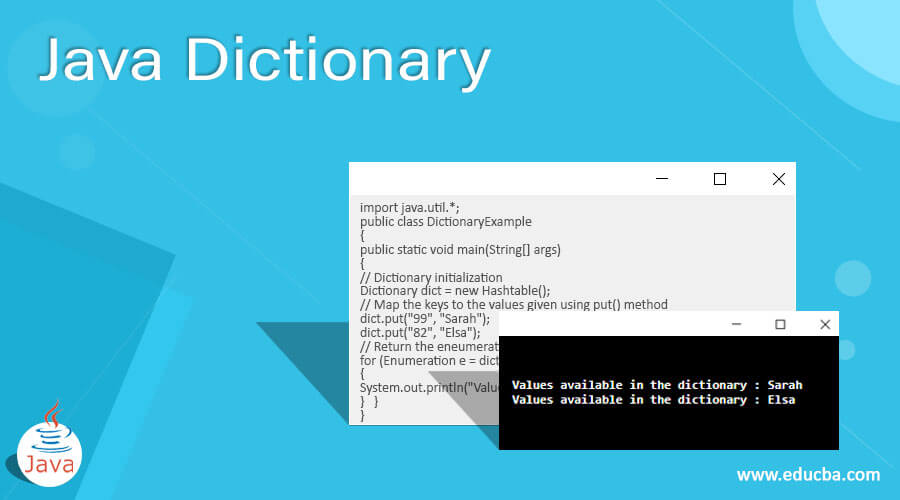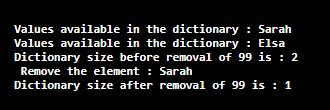Updated June 14, 2023

Introduction to Java Dictionary Class
In java Dictionary, util.Dictionary is an abstract class that denotes a key-value storage repository and behaves like a map. If a key and some values are given, values can be stored in the dictionary object. After saving the value, it can be retrieved by using the key. This similarity to maps is why the dictionary class is often referred to as functioning similarly. Subsequent sections will cover the constructors, declarations, and additional details of the dictionary class.
Declaration
Below is the declaration of the dictionary class.
public abstract class Dictionary extends objectConstructors
The following is the only constructor of the Dictionary class.
Dictionary() : Sole constructor.
How does the Java Dictionary class work?
As discussed above, the dictionary class is an abstract class that behaves similarly to the map. By providing specific keys and values, you can save the values in the dictionary object. After storing the value, it can be retrieved by using the key. You can use any non-null key and value in this class.
Java Dictionary Class Methods
Let us see different methods of Dictionary class.
elements()
The dictionary will return an enumeration of the values available in it.
Syntax:
public abstract Enumeration elements()Example:
import java.util.*;
public class DictionaryExample
{
public static void main(String[] args)
{
// Dictionary initialization
Dictionary dict = new Hashtable();
// Map the keys to the values given using put() method
dict.put("99", "Sarah");
dict.put("82", "Elsa");
// Return the eneumeration of dictionary using elements() method
for (Enumeration e = dict.elements(); e.hasMoreElements();)
{
System.out.println("Values available in the dictionary : " + e.nextElement());
} }
}Output:

Two elements are added to the dictionary, and you can retrieve the values of those keys using the elements() method.
put(K key, V value)
The key mentioned will be mapped to the value given.
Syntax:
public abstract V put(K key, V value)Example:
import java.util.*;
public class DictionaryExample
{
public static void main(String[] args)
{
// Dictionary initialization
Dictionary dict = new Hashtable();
// Map the keys to the values given using put() method
dict.put("101", "Anna");
dict.put("202", "Adam");
// Return the eneumeration of dictionary using elements() method
for (Enumeration e = dict.elements(); e.hasMoreElements();)
{
System.out.println("Values available in the dictionary : " + e.nextElement());
}
}
}Output:

Two elements are added to the dictionary using put() methods, and the values of those keys are retrieved later.
remove(Object key)
The key and corresponding value will be removed from the dictionary.
Syntax:
public abstract V remove(Object key)Example:
import java.util.*;
public class DictionaryExample
{
public static void main(String[] args)
{
// Dictionary initialization
Dictionary dict = new Hashtable();
// Map the keys to the values given using put() method
dict.put("99", "Sarah");
dict.put("82", "Elsa");
// Return the eneumeration of dictionary using elements() method
for (Enumeration e = dict.elements(); e.hasMoreElements();)
{
System.out.println("Values available in the dictionary : " + e.nextElement());
}
// remove the element 99 using remove() method
System.out.println(" Remove the element : " + dict.remove("99"));
// Return the eneumeration of dictionary using elements() method
for (Enumeration e = dict.elements(); e.hasMoreElements();)
{
System.out.println("Values available in the dictionary after removal: " + e.nextElement());
}
}
}Output:

After adding two elements to the dictionary, you can remove one of them using the remove() method.
keys()
An enumeration will be returned for the keys available in the dictionary.
Syntax:
public abstract Enumeration keys()Example:
import java.util.*;
public class DictionaryExample
{
public static void main(String[] args)
{
// Dictionary initialization
Dictionary dict = new Hashtable();
// Map the keys to the values given using put() method
dict.put("101", "Anna");
dict.put("202", "Adam");
// Return the enumeration of dictionary using elements() method
for (Enumeration e = dict.keys(); e.hasMoreElements();)
{
System.out.println("Keys available in the dictionary : " + e.nextElement());
}
}
}Output:

Two elements are added to the dictionary and can be retrieved using the keys() method.
isEmpty()
Checks whether the dictionary maps no key value. If there is no relation, true will be returned. Else, false.
Syntax:
public abstract booleanisEmpty()Example:
import java.util.*;
public class DictionaryExample
{
public static void main(String[] args)
{
// Dictionary initialization
Dictionary dict = new Hashtable();
// Map the keys to the values given using put() method
dict.put("101", "Anna");
dict.put("202", "Adam");
// Checks no key-value pairs
System.out.println("Is there any no key-value pair : " + dict.isEmpty() + " \n " );
}
}Output:

When key-value pairs exist in the dictionary, calling the isEmpty() method will return false.
get(Object key)
The dictionary will return a value that corresponds to the specified key.
Syntax:
public abstract V get(Object key)Example:
import java.util.*;
public class DictionaryExample
{
public static void main(String[] args)
{
// Dictionary initialization
Dictionary dict = new Hashtable();
// Map the keys to the values given using put() method
dict.put("99", "Sarah");
dict.put("82", "Elsa");
// Return the eneumeration of dictionary using elements() method
for (Enumeration e = dict.elements(); e.hasMoreElements();)
{
System.out.println("Values available in the dictionary : " + e.nextElement());
}
System.out.println(" Remove the element : " + dict.remove("99"));
for (Enumeration e = dict.elements(); e.hasMoreElements();)
{
System.out.println("Values available in the dictionary after removal: " + e.nextElement());
}
System.out.println("The value of the key 82 is : " + dict.get("82"));
}
}Output:

After adding two elements to the dictionary, you can retrieve one of them using the get() method.
size()
The number of entries will be returned, which is available in the dictionary.
Syntax:
public abstract intsize()Example:
import java.util.*;
public class DictionaryExample
{
public static void main(String[] args)
{
Dictionary dict = new Hashtable();
dict.put("99", "Sarah");
dict.put("82", "Elsa");
for (Enumeration e = dict.elements(); e.hasMoreElements();)
{
System.out.println("Values available in the dictionary : " + e.nextElement());
}
System.out.println("Dictionary size before removal of 99 is : " + dict.size());
// remove the element 99 using remove() method
System.out.println(" Remove the element : " + dict.remove("99"));
System.out.println("Dictionary size after removal of 99 is : " + dict.size());
}
}Output:

To identify the size of the dictionary, you can utilize the size() method before and after removing an element.
Conclusion
This article explains several aspects of Dictionary class, such as the declaration, constructors, working, and methods, with examples, in detail.
Recommended Articles
We hope that this EDUCBA information on the “Java Dictionary” was beneficial to you. You can view EDUCBA’s recommended articles for more information.


